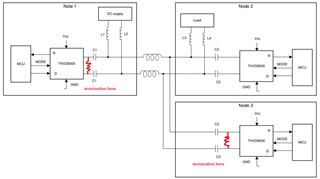Other Parts Discussed in Thread: ESD122
Dear *,
We want to use THVD8000 and have some design questions. Here are our specifications:
Max number of slave devices : 8
Bus Voltage 48V
Max Master output current 5A ( max power 240W)
Max Slave input current 1.25A
( in case 1-4 slaves max slave current is 1.25A ( 60W per slave) , 5slaves = 1A ( 48W per slave) , ... , 8slaves = 0.625A ( 30W per slave))
Communication speed : 0.5Mbps ( 5MHz carrier)
THVD8000 VCC = 3.3V
Questions:
1) Termination ( we want to use termination)
1a) Master - where is the right place to put the termination on Master module? and what value should we use?
1b) Slave - where is he right place to put the slave termination ? and what value should we use?
2) Capacitor selection per equation in DS
Is it ok to use 10nF 200V X7R 1206 ?
3) Inductor selection pre equation in DS
Is it ok to use 100uH 1.7A SRR1260-101M SRF=6MHz ?
4) The upper calculation is made if 8 slaves are connected to master device.
If we connect lower number of slaves to master ( eg. 1, 2, ... , 6, 7) , and the connected salve has 10nF and 100uH will this then work?
We want to have one slave with same components that will work in following configurations:
1master -> 1slave
1master -> 2slave
...
1master -> 7slave
1master -> 8slave
5) Is there a point to add additional ESD diode like ESD122 on Pin 6 and 7 of THVD8000
6) how can we estimate cable max length for the above specification ?
7) if the cable used is not twisted pair what kind of filtering should we use and where? Is it for this purpose ok to use CMC on power after the inductor on slave device?
Best Regards,
David.


